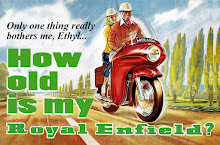 |
| Author Anne Bradford has died, at 91. |
Author and historian Anne Bradford won a permanent place in the world of Royal Enfield motorcycles with her 1996 book, "Royal Enfield, The Story of the Company and the People Who Made It Great, 1851-1969."
The book, a compilation of interviews with former workers at Royal Enfield factories in the UK, captures the memories of the people who created Royal Enfield in Britain. Most of the people she interviewed are gone.
And now the author herself has passed away.
Anne Margaret (Russon) Bradford, born April 9, 1934, died Nov. 30, 2025. A memorial service for her is 12:30 p.m. Friday, Dec. 19, 2025 at Redditch Crematorium.
Bradford called herself "an oral historian," a task for which she was well qualified, as a former teacher of shorthand. In retirement she became a writer.
"I have written about 30 books and dozens of booklets," she noted at one point.
"I concentrate on local material. The most popular is ghosts, murders and scandals. Haunted Pubs has sold well over 2,000. However, one book has bombed; my grandson... wrote a local ghost book to encourage him to read and we still have 500 stuck in the outhouse."
There was more to this spunky lady. Her obituaries appear in the Redditch Advertiser and the Redditch Standard.
Bradford lived and sold books from a small house at 66 Enfield Road, in the Hunt End neighborhood of Redditch. There's a colorful story about how her house led to her writing a book about Royal Enfield.
Blogger Jorge Pullin tells it on his blog My Royal Enfields:
"Redditch historian and Royal Enfield author Anne Bradford says that her interest in Royal Enfield started because local historians claimed that the house she lived in was the Givry Needle Works, which later became the first Royal Enfield factory in Hunt End.
"It turns out this is not true, the Hunt End factory was destroyed by a fire and there is now an industrial estate in the place it used to occupy. However, it is true that Anne Bradford's house was a replica of the construction that anchored the Givry needle works."
 |
| Anne Bradford's book is a must read for Royal Enfield enthusiasts. |
On my blog I called the book that resulted "The Royal Enfield history you must read.
"It is more than a history book," I wrote. "It is the affecting story of ordinary (and extraordinary) Royal Enfield employees, told in their own words.
"Readers learn not only how these people contributed to Royal Enfield, but how the company intersected with their lives, sometimes through generations."
That Bradford wasn't a motorcyclist herself is obvious in a 1995 letter she wrote to Doug Young, then the archivist of the Royal Enfield Owners Club (REOC). The club apparently had invited her to an event.
"To my surprise, I thoroughly enjoyed the rally," she wrote. "It was nice to meet everyone, and very interesting to see the bikes after reading up on the theory."
Her book is listed for sale on Amazon and as available on Kindle.
But wait. There's more:
In another 1995 letter to Young she wrote "I'm very disappointed that not all of every interview can be included as I have made many friends among the interviewees but I suppose the book will be all the better for the stringent editing."
Fortunately, her concern for local history never flagged, and she expressed her determination to leave full copies of the interviews with the Redditch Library and the REOC.
I've made an attempt to mine those outtakes for tidbits that I think add to the story of Royal Enfield in the UK. You'll find the resulting blog items at these links:
Anne Bradford's magnificent outtakes
More from Anne Bradford's archive
More of "The People Who Made It Great"
Donations in memory of Anne Bradford are welcome to Alcester Day Care Centre at Justgiving.
The Redditch Local History Museum collection of history books is named The Anne Bradford Heritage Library in her honor.

































